 Your usual server won't be with you tonight. She's come down with a small case of murder. 
The Swinging Barmaids, which splashed across U.S. screens for the first time this month in 1975, is one of those movies with a deliberately misleading title. Rather than the breezy erotic romp you'd expect, it's a thriller about an insane serial killer who stalks a group of waitresses working in a Los Angeles go-go bar. The problems commence when Dyanne Thorne (yes, she made movies aside from the Ilsa atrocities) is stabbed to death, setting off an inept police investigation, while the killer sets his crazy sights on more victims. He's the classic maladjusted loner you find in ’70s grindhouse filcks. You know the type: “You're the first girl I ever met that wasn't dirty underneath.” What type of woman wouldn't immediately leave town after hearing something like that? Answer: a woman in a bad movie. Eventually, to facilitate his homicidal efforts, Mr. Maladjustment gets a job as a dishwasher at the bar. More killings eventually lead to the unveiling of this wolf in the fold, and his inevitable perforation with 12-gauge buckshot. That isn't a spoiler. His death is the entire point of the film. Well, that and boobs. But the problem is that this is all mounted perfunctorily, is poorly written, visually lackluster, narratively sluggish, and devoid of actorly charisma. In fact, if not for the nudity, you'd think The Swinging Barmaids was a minor television movie. The best thing going for it is the above poster art by the incomparable John Solie. Check, please.
        
 Every successful woman has a great support system.  
Actually, a great woman often has nothing but her own sheer will, but a little support never hurts. This photo shows Ava Gardner getting a boost from Burt Lancaster somewhere on Malibu Beach in 1946. It was made while they were filming The Killers, and there are several more shots from the session out there if you're inclined to look. We've shared a lot of art from The Killers, which you can see here, here, here, here, and here. And, of course, you should watch the movie.
 Oh, you said a straight line? I misheard you. Let me start over.   
Once again you have to marvel that it was legal for press photographers to intrude on crime scenes, criminal trials, and—now it seems—traffic stops. You see the evidence above. An unidentified woman is put through the paces of a sobriety check by a Los Angeles patrolman, and it looks to us like the shots capture a spectacular failure. Either that or she's busting into “The Night They Invented Champagne” from the musical Gigi. She was arrested either way—for drunkenness or flippancy—and presumably had hours of idle time in a drunk tank to ponder the error of her ways. That happened today in 1958.
 In an L.A. minute anything can be stolen. 
The now-cult movie Gone in 60 Seconds is remembered partly because the 2000 Nicolas Cage remake rekindled interest, but also because a man named H.B. Halicki is famous for being the producer, writer, star, director, and stunt coordinator. He's a classic example from an earlier era of Hollywood of a guy with knowledge specific to an industry who dreamt up a story then cobbled together the funds to put his vision on the screen. He was a car mechanic who for years had been owner of a Southern California junkyard. In his work life he'd conceived or learned of a foolproof method for stealing and reselling cars. It involved boosting cars that were identical to wrecks, then swapping vehicle identification numbers and other elements so the stolen car disappeared and the wreck was reborn as a new ride. The technique became well known eventually, but back then it wasn't. That idea provided Halicki's entree into the world of moviemaking.
You see a Japanese poster above, with one more plus promo shots below. The movie opened in the U.S. in 1974, and premiered in Japan today in 1975. It's what some people these days like to call car porn, as audiences get to see formula one cars, custom sports cars, limousines, and a customized Ford Bronco owned by Parnelli Jones, who has a cameo in the film. The centerpiece (really more like the endpiece) is a forty minute chase sequence that in order to film allegedly resulted in ninety-three wrecked cars. Storywise, it's about an insurance investigator who moonlights as a professional car thief, who accepts a contract from a South American drug cartel to provide forty-eight luxury cars by week's end. The task seems impossible, but failure isn't an option. Several complications arise. Halicki, playing a character named Maindrian Pace, is called upon to investigate the very thefts his ring is perpetrating. When one of his crew steals a car packed with heroin things start to get really complicated.
That's all fine and fun, and Halicki's personal Hollywood success story is an inspiring one, but the movie does still have the touch of amateurism about it, particularly in the acting. That's to be expected with a quickly mounted production, starring a first-timer who also cast various family members and amateurs in small roles. In the writing area, the characters are mere sketches, which worked fine in other indie flicks from the period like Two-Lane Blacktop, but somehow doesn't quite come to fruition here. The great director John Huston once said Hollywood had a bad habit of remaking good movies. They should remake the bad ones, he advised. Since the remake wasn't as good as it could have been either, Gone in 60 Seconds could probably still use a revamp, but until that time comes audiences will have to make do. Halicki thought outside the box (did we mention the forty minute car chase?) which means his original Gone in 60 Seconds is the only one to watch.           
 If Donald Sterling's comments embarrassed NBA team owners, what will they think about an entire mini-series? 
We don't watch a lot of new television series, but when we heard about Hulu's Clipped we decided to have a look. It's about the dysfunctional reign of billionaire Donald Sterling as owner of the NBA's Los Angeles Clippers, and it happens that ten years ago, back when we still had the time and inclination to write about public scandals as a subset of pulp, we touched on the subject. We used to watch a lot of NBA, but around then we drifted away from the sport and haven't watched it since. It wasn't a conscious decision, but looking back, the plantation mentality of league owners like Sterling may have had something to do with it
In short, Sterling is a billionaire real-estate mogul whose wealth insulated him from consequences that should have taken him down decades earlier. It was a woman that finally did him in. His misbehavior came out in the open when his (possibly non-sexual) mistress V. Stiviano shared an audio rant of Sterling haranguing her because she'd taken a photo with ex-basketball star Magic Johnson and posted it online. Sterling didn't want Stiviano—who's black and Mexican—seen in public with people of color, and didn't want her bringing black friends to Clippers games. It was a problematic and indefensible attitude, to say the least.
The audio clip revealed to the world what sports fans around L.A. (including us) had known for years—that the city's massive fanbase meant Sterling didn't need to spend money improving the team, he had little interest in winning, and held proprietary and retrograde views of black athletes. Sterling denied that his rant was racist, of course, and exhibited the moral outrage that is the default setting for people exposed for terrible views. In reality, he was like a walking, talking villain from a blaxploitation movie. If Pam Grier had burst through the door and karate chopped him to the floor nobody would have blinked.
Hulu has released two of the six episodes of Clipped. The show has a great tone, nudging up against farce though it's based on reality. Laurence Fishburne is excellent as Clippers head coach Doc Rivers, as is Cleopatra Coleman as Stiviano, but the showrunners' coup was in casting ex-Al Bundy portrayer Ed O'Neill as Sterling. He's pitch perfect  as an elderly, insulated billionaire who constantly tells himself he's brilliant, yet refuses to understand that the reason things it was “okay” to say in the past are problematic now is because in the past the people he mistreated couldn't make their protests heard. They always hated it. Digital technology, the internet, and social media finally provided them a voice. Entire swaths of America are still refusing to adjust to this tipping of the scales toward a slightly more equal reality. as an elderly, insulated billionaire who constantly tells himself he's brilliant, yet refuses to understand that the reason things it was “okay” to say in the past are problematic now is because in the past the people he mistreated couldn't make their protests heard. They always hated it. Digital technology, the internet, and social media finally provided them a voice. Entire swaths of America are still refusing to adjust to this tipping of the scales toward a slightly more equal reality.
Clued in sports fans have always understood that Sterling's attitude is common among owners in the NBA (and NFL), but the revelations shocked casual fans and looked dangerous for the league's bottom line. Sterling's peers, driven by the instinct for self-protection and self-policing that keeps their clan out of congressional hearings, proactively drummed him out of their cosseted circle. Therefore the ending of Clipped is pre-written, but even so, we bet there are some amusing surprises in store. If you like sports, enjoy insider info on athletes, and can laugh at the absurd, then Clipped is good fun. It can't make NBA owners happy, but we're sure enjoying it.
 The L.A. dead get a voiceover. 
This photo which was made by an LAPD crime scene photographer today in 1953 seems to show a murder victim, but the subject actually committed suicide. We guess that's self-murder, but whatever, it's an amazingly chaotic result. While it's from the LAPD archvies, it was included in James Ellroy's 2015 photo retrospective LAPD '53. We have a copy and it's worth a look for fans of the macabre. There isn't much information on the photos—mostly they say merely “dead body” or “crime scene.” Ellroy instead discusses his own literary output, opines about film noir, shares anecdotes and musings about various Hollywood figures, recounts episodes from his youth, and occasionally lets himself be pulled down dark time warps he describes as “magical memory.” A typical example is his imaginary story of being at L.A.'s Club Alabam.
 Charlie “Yardbird” Parker is bleating, blatting, honking and hiccuping “A Night in Tunisia.” Reefer smoke hangs humid. The music is decadently discordant. It’s the sock-it-to-me sonics of interminable chord changes off a recognizable main theme. It’s music for cultured cognoscenti that Bill Parker [LAPD Chief at the time] cannot acknowledge. Charlie “Yardbird” Parker is bleating, blatting, honking and hiccuping “A Night in Tunisia.” Reefer smoke hangs humid. The music is decadently discordant. It’s the sock-it-to-me sonics of interminable chord changes off a recognizable main theme. It’s music for cultured cognoscenti that Bill Parker [LAPD Chief at the time] cannot acknowledge.
It takes brains and patience to groove the gist of this shit. It’s the musical equivalent of the chaos Bill Parker deplores. Five-year-old Ellroy is there, watching the Bird take flight. Everybody’s chain-smoking unfiltered Camels. The place is one big corroded iron lung. I’ve got a spike in my arm, I’m orbiting on Big “H,” I knew I’d write the text for this book one day, so I’ve got my voyeur’s cap on.
Interesting, no? Ellroy's writing these days resides permanently on a razor's edge, as he ties together crime, politics, and alpha male ultraviolence. He seem to us the perfect transgressive guide for LAPD '53's tour through disaster and death for two reasons. First, he isn't just an observer—he was a one-man terror show in his own right, engaging in petty crime through his youth, joining the American Nazi Party in high school, and generally leaving chaos in his wake. He waves this period away as a cry for attention. His fame and teflon persona have facilitated this dismissal, and that's the second reason he's a good choice for the book: other people pay dearly for indiscretions far less severe, like the universe has played a terrible joke on them. Ellroy's fiction has always explored such cosmic inexplicability. He makes LAPD '53 an experience.

 Fear and loathing are the least of his problems. 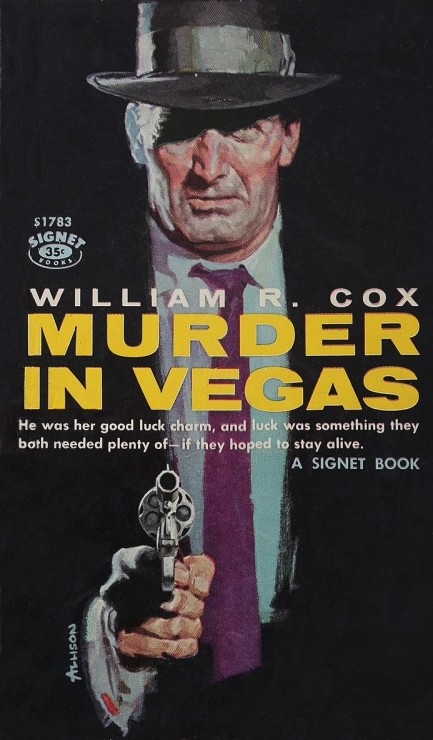
Jerry Allison art strikes a menacing note on the cover of William R. Cox's 1960 novel Murder in Vegas, in which Cox's gambler hero Tom Kincaid from 1958's Hell To Pay, which we recently discussed, returns to the written page to find more trouble. The first murder in the book actually occurs in Los Angeles, but someone is later knocked off in Vegas and as a direct result Kincaid is elevated from silent partner to full owner of a casino called the White Elephant. Simultaneously his girlfriend Jean Harper is in town filming a movie, and the murder and film production seem tied together. Kincaid is as interesting as before, but the fun creation here is down-on-her-luck party girl Carry Cain, who mixes sexiness and vulnerability with a beatnik mentality. She's an aspiring actress and gambling addict who thinks Kincaid might finally bring her the luck she's been seeking. Instead she finds herself in the middle of a Vegas-sized mess. Cox has talent, as we've noted before. It shines bright in Murder in Vegas.
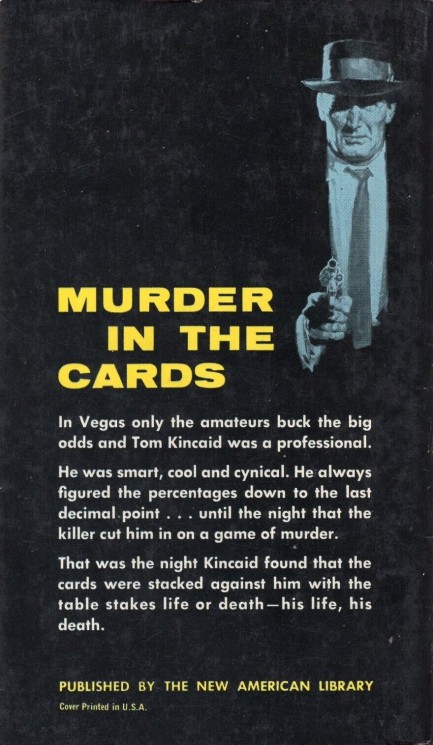
 Take a picture, perv. It'll last longer. 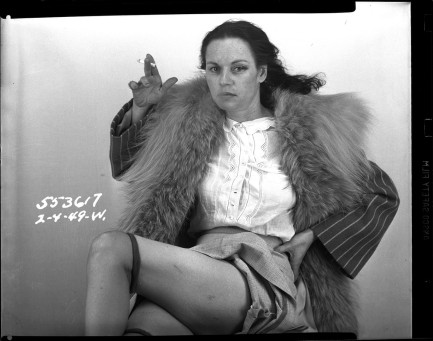 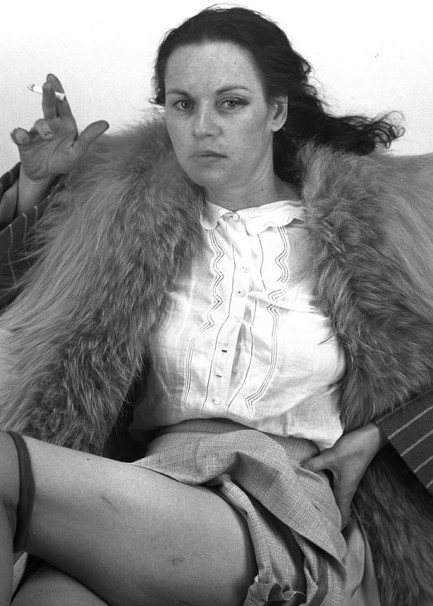
Above is another striking image from the 2019 Lucie Foundation exhibit of Los Angeles crime photos, most of which have been widely disseminated across the internet since then. That means we can always grab one when we want to dip into the mid-century crime underworld. The subject here, with her unfliching gaze and lit cigarette, has been arrested but there's no info revealing why. We're thinking public check and pinstripe clashing? No, probably not that. Imitating Sharon Stone in Basic Instinct? No, that was before her time. Felony cruelty to fur-bearing mammals? No. Okay, here's a shot in the dark—probably she was arrested for prostitution. That's our final guess. The photo was made today in 1949.
 I'd have sex for free, but that would be irresponsible from a business perspective. 
The 1962 Signet paperback of The Hundred-Dollar Girl has striking cover art by Jerry Allison, whose nice work we've seen before here, here, and here. William Campbell Gault's tale sees L.A. private dick Joe Puma investigating whether a boxing match was fixed, then finding himself in the middle of murder and an organized crime takeover of the fight racket. This is the second Puma we've read, and as with the previous book, he gets laid a couple of times, gets ko'd a couple of times, and beats up a couple of guys. All this is fine, but we haven't yet read the Gault novel that makes us sit up and go, "Ahh!" Certainly though, he's been good enough to make looking for that special book a pursuit we expect to pay off. We'll keep looking. In the meantime, if you want an L.A. crime read, you can do worse than The Hundred-Dollar Girl.
 You’re nobody ’til somebody loves you. 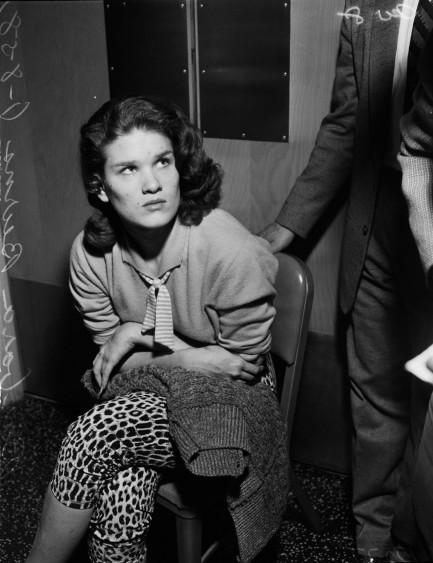 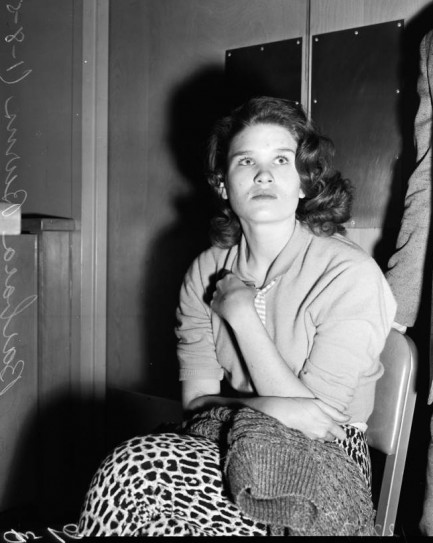
The above photos show Barbara Burns when she was busted for drugs today in 1958 after LAPD officers found track marks on her arms. Burns was the well-to-do daughter of famed comedian Bob Burns, but her father had died of kidney cancer in 1956. Barbara Burns was sentenced to probation after the arrest, and the story got some play in national newspapers, with several calling her probation sentence a storybook opportunity at a second chance. But she didn’t cooperate in the role. She managed to cobble together some behind-the-cameras television work, but was arrested for heroin possession in 1959. That time she served ninety days in jail and admitted in an interview, “I’m really hooked. I had nothing else to do, and my mother wouldn’t talk to me. I wanted to be a singer but I was too heavy and they told me it would help me lose weight.” Burns had always called herself an ugly duckling, compared herself unfavorably to her siblings, and felt she could never live up to family expectations. But even though her own words told the world that low self esteem was the root of her problems, a dead father and an estrangement from her mother probably didn't help things. The downward spiral continued. She was arrested for marijuana possession in early 1960 and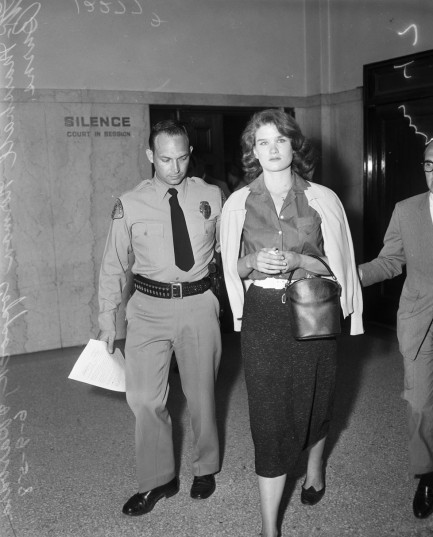 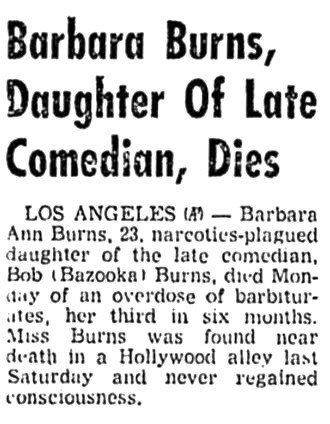 earned ninety days in Camarillo State Hospital. In November 1960 she was snared in another weed bust, but that time she walked after a jury acquitted her. When she was arrested for heroin possession again in June 1961, she lamented what had probably been true for longer than she admitted—that she had doomed her chance to have a career in show business. earned ninety days in Camarillo State Hospital. In November 1960 she was snared in another weed bust, but that time she walked after a jury acquitted her. When she was arrested for heroin possession again in June 1961, she lamented what had probably been true for longer than she admitted—that she had doomed her chance to have a career in show business.
At some point she sought medical treatment for an eye problem and was told by a doctor that she was losing her vision in her right eye. In both August and September of 1961 she attempted suicide, and in January 1962 while awaiting trial on one of her narcotics busts she was found overdosed and unconscious on a Hollywood street, and died a few days later in the hospital. Her suicide note said all she wanted was to be loved but everyone hated her. Many of her obituaries, ironically, described her as “tall and beautiful,” which she certainly would not have believed. They also noted her advantages in life—how she had won the crucial lottery of being born to wealth. But Barbara Burns didn’t see it that way. She once said, “I wish I had been born in some poor, obscure family that nobody knew. Then maybe I would have tried to become somebody.”

|
 |

The headlines that mattered yesteryear.
2003—Hope Dies
Film legend Bob Hope dies of pneumonia two months after celebrating his 100th birthday. 1945—Churchill Given the Sack
In spite of admiring Winston Churchill as a great wartime leader, Britons elect
Clement Attlee the nation's new prime minister in a sweeping victory for the Labour Party over the Conservatives. 1952—Evita Peron Dies
Eva Duarte de Peron, aka Evita, wife of the president of the Argentine Republic, dies from cancer at age 33. Evita had brought the working classes into a position of political power never witnessed before, but was hated by the nation's powerful military class. She is lain to rest in Milan, Italy in a secret grave under a nun's name, but is eventually returned to Argentina for reburial beside her husband in 1974. 1943—Mussolini Calls It Quits
Italian dictator Benito Mussolini steps down as head of the armed forces and the government. It soon becomes clear that Il Duce did not relinquish power voluntarily, but was forced to resign after former Fascist colleagues turned against him. He is later installed by Germany as leader of the Italian Social Republic in the north of the country, but is killed by partisans in 1945.
|

|
|

It's easy. We have an uploader that makes it a snap. Use it to submit your art, text, header, and subhead. Your post can be funny, serious, or anything in between, as long as it's vintage pulp. You'll get a byline and experience the fleeting pride of free authorship. We'll edit your post for typos, but the rest is up to you. Click here to give us your best shot.

|
|



























![]()






 as an elderly, insulated billionaire who constantly tells himself he's brilliant, yet refuses to understand that the reason things it was “okay” to say in the past are problematic now is because in the past the people he mistreated couldn't make their protests heard. They always hated it. Digital technology, the internet, and social media finally provided them a voice. Entire swaths of America are still refusing to adjust to this tipping of the scales toward a slightly more equal reality.
as an elderly, insulated billionaire who constantly tells himself he's brilliant, yet refuses to understand that the reason things it was “okay” to say in the past are problematic now is because in the past the people he mistreated couldn't make their protests heard. They always hated it. Digital technology, the internet, and social media finally provided them a voice. Entire swaths of America are still refusing to adjust to this tipping of the scales toward a slightly more equal reality.

 Charlie “Yardbird” Parker is bleating, blatting, honking and hiccuping “A Night in Tunisia.” Reefer smoke hangs humid. The music is decadently discordant. It’s the sock-it-to-me sonics of interminable chord changes off a recognizable main theme. It’s music for cultured cognoscenti that Bill Parker [LAPD Chief at the time] cannot acknowledge.
Charlie “Yardbird” Parker is bleating, blatting, honking and hiccuping “A Night in Tunisia.” Reefer smoke hangs humid. The music is decadently discordant. It’s the sock-it-to-me sonics of interminable chord changes off a recognizable main theme. It’s music for cultured cognoscenti that Bill Parker [LAPD Chief at the time] cannot acknowledge.












 earned ninety days in Camarillo State Hospital. In November 1960 she was snared in another weed bust, but that time she walked after a jury acquitted her. When she was arrested for heroin possession again in June 1961, she lamented what had probably been true for longer than she admitted—that she had doomed her chance to have a career in show business.
earned ninety days in Camarillo State Hospital. In November 1960 she was snared in another weed bust, but that time she walked after a jury acquitted her. When she was arrested for heroin possession again in June 1961, she lamented what had probably been true for longer than she admitted—that she had doomed her chance to have a career in show business.




































































